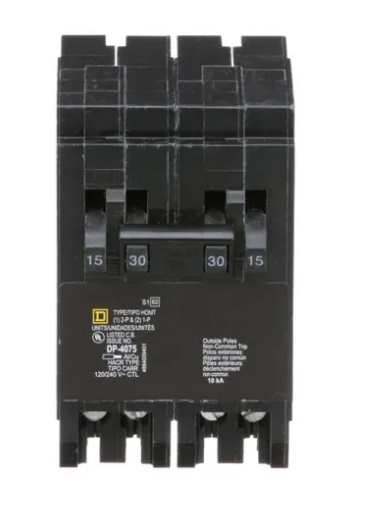I only want to understand the concept, so you dont have to address if my panel accepts tandem breakers or a certain brand of breakers. I will also omit any reference to ground wires for clarity. I am in north america and have two 120v hots and one neutral coming into my panel.
Thank you for any help!
PART 1:
I want to see if i properly understand how to wire 2-Pole Quad Circuit Breakers.
Here is an example pic:

To wire this breaker, I would run three cables, lets say romex. two of the three would be identical – they would be 14/2 (14 gauge wire, with one hot, one neutral).
One cable of romex will go to the top 15amp breaker, and one to the bottom 15 amp breaker — I Would attach the hot wire to the top screw, and bring the neutral to the neutral bus, and repeat the same process for the bottom, with its own hot and neutral from the second strand of romex. These 2 now function like independent 120v, 15 amp circuit breakers.
Next, the third strand of romex. It would need to be at least 10gauge wire because the center breaker is 30 amp. It would also need to be 3 wire romex with two hots, and one neutral.
I would attach the two hots to the two center screws, and the neutral to the neutral bus. Now it functions like a 240v, 30 amp double pole breaker.
Does part 1 all look correct? If so, here are my next questions for part 2 and 3:
Part 2:
Focusing only on the 30 amp, 240v middle part:
I run the 10gauge romex to a box and i install a 30 amp 240v outlet, that has 3 slots including ground slot. i would connect the two hots, and ground.
(I just cap the neutral off with a wire nut and leave it for future expansion of more outlets down the line, or if i want to change to a four prong outlet that needs a neutral, correct?)
This outlet can now supply a device with 7,200 watts (240v x 30amps), or for safety, 80% of 7,200 watts, which is 5,760 watts.
What if instead of installing the 30amp outlet, i want to install 2 receptacles, lets say they are both 20 amp duplex outlets.
To wire them, I connect one hot wire to the gold screw of the first outlet, and the other hot to the gold screw of the second outlet. I pigtail the neutral wire, and connect 1 pigtail each to the silver screw of outlet 1 and 2.

I believe this would be called a multi-wire branch circuit (mwbc)?
Each receptacle can safely handle 1,920 watts of power draw, which is 80% of 120v x 20amps. So if i have two devices that both draw about 1,900 watts of continuous power, i could plug one into one receptacle, and one into the other receptacle, and they could both safely run without tripping the breaker, or overheating, is this all correct?
Ok, so if everything is correct so far, here is my final question:
Part 3
Lets say instead of the first quad breaker show, i buy this one:

Now the two outer 15amp breakers are tied together, and i assume they internally trip together. So lets say instead of running the two separate 14/2 romex cables to these two 15 amp breakers, i now run just one 14/3 romex, and i connect one hot to the top, and one hot to the bottom, and neutral to bus.
I could now have a mwbc like the example above, except with 15 amp outlets, and each receptacle would only safely supply 1,440 watts (80% x 120v x 15amps).
Im guessing I could also then wire a single 15amp outlet rated for 240v, in a similar method to the wiring of the 30amp outlet described above? I dont think there is any reason to do that in america, because no devices require that, or have a plug that would fit, but im just curious.
Is this all okay to do, since they will now trip together, and must be shut off together?
Thank you so much for your time!
Best Answer
Your understanding is correct EXCEPT you cannot put a 15A or 20A receptacle on a 30A breaker. The 30A circuit must be wired to an outlet that is designed for 30A. This would be a NEMA 6-30 if you don't need the neutral, or a NEMA 14-30 if you do (or the NEMA L-series locking equivalents).
There are devices factory-wired for these plug types in America. The most common example is dryers on a NEMA 14-30 plug, but also welders, electric car chargers, and some shop machinery also use the NEMA 6 or NEMA 14 series plugs sometimes.